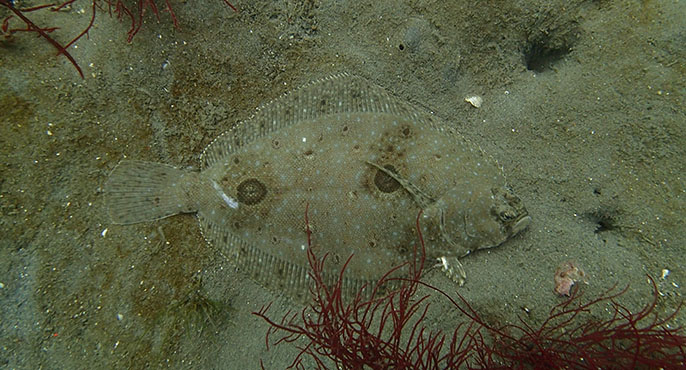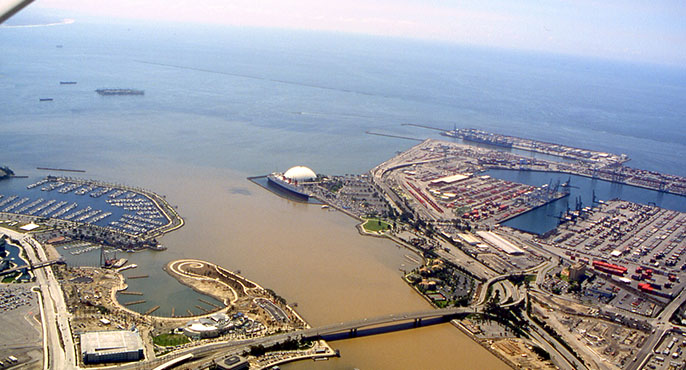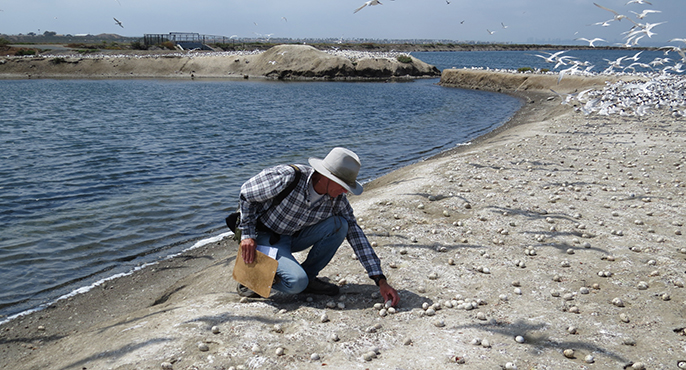![]() The quality of seafloor sediment is a sentinel indicator of the health of coastal marine ecosystems. As land-based chemical pollutants are discharged into coastal waters, these contaminants tend to stick to particulate matter suspended in the water column and settle to the seafloor, where they can remain toxic for decades. Humans and most wildlife will never come into direct contact with this surface layer of sediment, but organisms like burrowing worms and crustaceans spend their entire lives here – and these organisms form the base of food webs that extend all the way to humans. By understanding how sediment-based chemical contamination is transferred through food webs and how it can adversely impact wildlife and humans, California’s environmental management community becomes better-positioned to focus and direct resources to mitigate ecosystem damage.
The quality of seafloor sediment is a sentinel indicator of the health of coastal marine ecosystems. As land-based chemical pollutants are discharged into coastal waters, these contaminants tend to stick to particulate matter suspended in the water column and settle to the seafloor, where they can remain toxic for decades. Humans and most wildlife will never come into direct contact with this surface layer of sediment, but organisms like burrowing worms and crustaceans spend their entire lives here – and these organisms form the base of food webs that extend all the way to humans. By understanding how sediment-based chemical contamination is transferred through food webs and how it can adversely impact wildlife and humans, California’s environmental management community becomes better-positioned to focus and direct resources to mitigate ecosystem damage.
Since the 1970s, SCCWRP has been a leader in helping environmental managers in coastal Southern California contain and remediate the ecosystem impacts of sediment contamination. SCCWRP and its research partners work to bring more standardization and quantitative rigor to how sediment quality is evaluated across California’s diverse coastal marine environments. Through the development of sediment quality assessment frameworks, researchers help California environmental managers methodically pinpoint which areas of the coastline are considered impacted by sediment contamination – and the relative degree of ecological risk to these environments.

Far-reaching impacts of sediment contamination
Unlike water-column contamination that is often quickly dispersed by ocean currents and tides, sediment contamination can continue to exert toxic effects for decades. Indeed, much of the contamination in California’s coastal seafloor sediment is caused by pollution that predates modern environmental laws. From trace metals to now-banned pesticides like DDT to industrial chemicals like PCBs and PBDEs, these legacy contaminants – along with new contaminants washing off the land every day – pose a threat to marine ecosystems and humans who consume locally caught seafood.
The most effective strategy that environmental managers use to prioritize remediation actions for contaminated sediment is toxicity identification evaluation (TIE), a form of stressor identification that SCCWRP and its partners have helped improve and refine. Via this analytical laboratory technique, researchers tease apart the many potential sources of stress on sediment-dwelling organisms at a given site, seeking to identify the most likely causes of sediment contamination-related stress. Sediment TIEs enable environmental managers maximize effectiveness of sediment management strategies, including TMDL (total maximum daily load) regulatory policies that place caps on pollutant loading to water bodies.
The three most common legacy contaminants that bioaccumulate through food webs in California coastal waters are:
- Mercury, a metal that causes impaired neural functioning, especially in children
- DDT (dichlorodiphenyltrichloroethane), a pesticide banned in 1972
- PCBs (polychlorinated biphenyls), a class of industrial chemicals banned in 1979

Direct and indirect effects of sediment contamination
SCCWRP’s sediment quality research program revolves around building technical approaches and tools that better protect sediment-dwelling biological communities and the humans and wildlife that can be exposed to sediment contamination via food web transfer.
- Direct effects on sediment-dwelling organisms: To quantify the direct effects of sediment contamination on sediment-dwelling biological communities, SCCWRP and its partners have developed a quantitative scoring tool based on the sediment quality triad. The triad uses a multiple-lines-of-evidence approach to evaluate how sediment-dwelling organisms are impacted by sediment contamination at a given site. Based on a concept pioneered in Washington’s Puget Sound in the 1980s, the sediment quality triad is used widely across Southern California to score sediment quality in bays and estuaries, as well as along the continental shelf to depths of about 200 meters. In 2009, following more than a decade of testing and refinement, the California State Water Resources Control Board adopted a version of this scoring tool to regulate sediment quality in enclosed bays and estuaries statewide.
- Indirect effects on wildlife and humans: Evaluating the effects of sediment contamination on wildlife and humans requires weighing two main variables: understanding whether the contaminants in fish and other foods consumed by wildlife and humans pose a health risk, and understanding the degree to which sediment contamination at a given site contributes to the contaminants found in foods consumed by wildlife and humans. SCCWRP and its partners are building bioaccumulation models that explain how contaminants are transferred through food webs, consumption risk models that estimate the health risks of eating contaminated seafood, and site linkage models that estimate the role of sediment contamination vs. other pollutant sources in contributing to seafood contamination.

